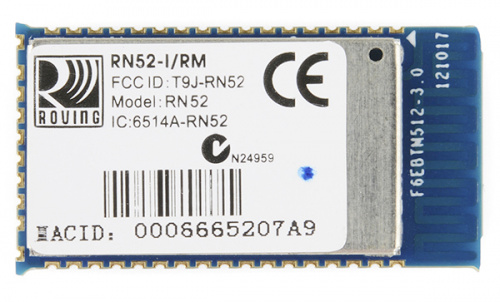RN-52 Bluetooth Hookup Guide
The RN-52 Module
Before we get in to the breakout board, let's discuss the module and its features.
As with any product, it is wise to read the datasheet before embedding this device into a project.
Bluetooth Version
The RN-52 is a Bluetooth v3.0 module. It is compatible with all Bluetooth v3.0 devices and also backwards compatible with all Bluetooth v2.1 + EDR, 1.2, and 1.1 devices.
Bluetooth Profiles
Here is a list of all the profiles that the RN-52 supports.
- SPP - Serial Port Profile allows you to configure the device over a UART serial connection. This can also be used to send commands to the module from a microcontroller.
- HFP/HSP - Support of both Hands-Free Profile and Headset Profile mean the module can act as a headset device. This allows the it to send audio back and forth, just like a Bluetooth headset. You can send audio input through a microphone and receive audio output through a speaker or headphones.
- A2DP - Advanced Audio Distribution Profile sends audio in one direction, but the quality of that audio is better than the quality of HFP and HSP.
- AVRCP - A/V Remote Control Profile allows you to control certain features of your audio through the module. Tasks such as Play/Pause, Volume Up, and Volume Down can be controlled by inputs on the module.
- iAP - This is the iPod Accessory Protocol, and it allows you to connect the module to any Apple devices such as iPhones, iPods, and Mac laptops and computers.
*Note: Multiple profiles can be implemented at once. The default settings are set to have all profiles discoverable.
Range
The RN-52 is a Class 2 Bluetooth device, meaning that the range of the on board antenna is about 10m. Thus, you should be able to stream audio to the module from about 32 ft in open air. If you are streaming through walls or windows, that range will diminish.
Wireless Audio
The RN-52 is different than other Bluetooth modules in that it can stream audio. It does this via an on-board Digital Signal Processing (DSP) chip. When streaming audio to the RN-52, the DSP converts the radio waves sent from the transmitter device (phone, computer, etc.) into electrical signals that can then be sent to the amplifier and then to your audio output (speakers/headphones). When streaming audio from the module, it converts the electrical signals from the audio input device (mic/line-in) to radio waves for the receiver device (stereo, computer, phone).
Many people ask why it isn't possible to send audio over just any old Bluetooth connection. The lack of an on-board DSP is the main reason most "regular" modules cannot support audio streaming.
Communication
Aside from a wireless Bluetooth connection, the RN-52 has four paths on which it can communicate to outside devices: UART, USB, SPI, and PCM. We'll discuss these in more depth in the next section.
